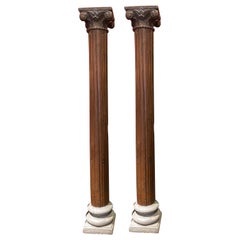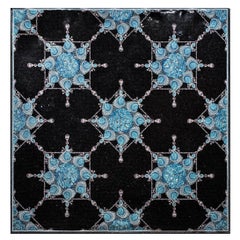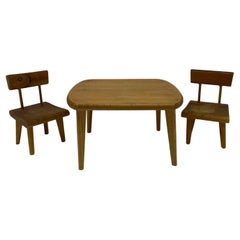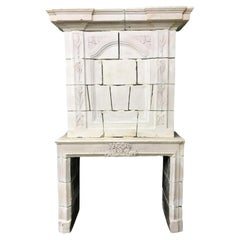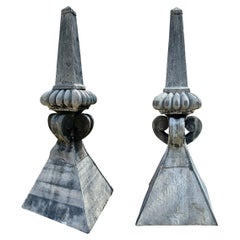Hand-Crafted Architectural Elements
to
60
180
110
290
19
1
Height
to
Width
to
29
27
17
16
10
9
7
6
6
5
5
4
4
4
3
1
49
118
123
20
49
43
11
6
1
14
1
1
15
8
2
2
153
79
73
57
33
184
73
63
53
29
310
292
300
7
7
5
2
2
Technique: Hand-Crafted
Antique Wrought Iron Signage Bracket
Located in Sheffield, MA
The antique wrought iron bracket is decorated with curls and a spear-like tip. Holes on the side bar can be used to secure to the side of...
Category
19th Century European Renaissance Antique Hand-Crafted Architectural Elements
Materials
Wrought Iron
19th Century Italian Architectural Corinthian Wood Columns on Stone Base - Pair
Located in Firenze, IT
This tall pair of Italian 19th century Louis XVI style hand carved walnut architectural columns with Corinthian capitals and stone base boasts a fluted and slender body crowned with ...
Category
19th Century Italian Classical Roman Antique Hand-Crafted Architectural Elements
Materials
Stone, Sandstone
$7,877 Sale Price
25% Off
Mural Marble and Glass Mosaic with Jewelry Design
By Alexander's Collection, Alexander Anisimov
Located in Hong Kong, HK
Mural Marble and Glass Mosaic with Jewelry Design
The legendary Alexander's Collection, a brand that initially made the name in the Asian markets, is now taking a breakthrough step...
Category
2010s Chinese Other Hand-Crafted Architectural Elements
Materials
Marble
$18,640 Sale Price / item
20% Off
Vintage Miniature Group of Midcentury Table and Chairs
Located in San Diego, CA
Group of Mid-Century Modern-style Miniature Wooden Furniture, featuring a table and two chairs. This vintage set was created by hand in the ...
Category
1960s American Mid-Century Modern Vintage Hand-Crafted Architectural Elements
Materials
Wood
$108 Sale Price / set
20% Off
17th C Louis XIV Hand Carved Stone Chateau Fireplace Mantle surround Los Angeles
Located in West Hollywood, CA
17th C Louis XIV Hand Carved Stone Chateau Fireplace Mantle surround Los Angeles . Very rare 17th century Louis XIV carved stone fireplace from a Chateau in Bourgogne "Burgundy" the ...
Category
17th Century French Louis XIV Antique Hand-Crafted Architectural Elements
Materials
Stone, Limestone
$28,000 Sale Price
20% Off
A Pair Of Monumental Lead Antique Obelisks Finials
Located in London, GB
A monumental pair of antique lead obelisk roof top finials, turrets. The pyramid shaped base with scrolled brackets supporting a gadrooned plinth and obelisk finials. Large and impo...
Category
1840s English Victorian Antique Hand-Crafted Architectural Elements
Materials
Lead
$19,462 / set
16th Century oak carved Gothic Panel, France
Located in Meulebeke, BE
16th century / Belgium / Letter Panel / Oak / Gothic
A finely carved Gothic oak panel from 16th-century France. This architectural fragment features graceful vertical fluting framed...
Category
16th Century Belgian Gothic Antique Hand-Crafted Architectural Elements
Materials
Oak
Mid-Century Modern Stained Glass Window #6 by Rainbow Studios NY, circa 1965
Located in Port Jervis, NY
Fabulous stained glass windows, 6 available, one posted separately in this listing. Rainbow Studios of Nyack NY did them in the mid sixties for a home i...
Category
1960s American Arts and Crafts Vintage Hand-Crafted Architectural Elements
Materials
Lead
Midcentury Stained Glass Window Panels by Rainbow Studios NY, circa 1965 #2
Located in Port Jervis, NY
Stunning set of stained glass window panels. This listing is for 1 panel. We have 6 available, all in separate listings. Fabulous colors a...
Category
1960s American Arts and Crafts Vintage Hand-Crafted Architectural Elements
Materials
Lead
Art Deco Plaster Relief of a Woman with a Greyhound Dept Store Installation
By Louis Icart
Located in Port Jervis, NY
Spectacular and a rare piece from the art Deco period. Fabulous relief of a scantily clad glamorous woman with a Greyhound that looks like it's in motion. The dog is leading the way ...
Category
1950s American Art Deco Vintage Hand-Crafted Architectural Elements
Materials
Steel
19th Century Wrought and Cast Iron Illuminated Neo-Gothic Overdoor
Located in Hastings, GB
One of the most outstanding pieces of ironwork we have ever seen, truly a one off spectacular mid-19th century iron overdoor, sourced from a Scottish estate this bespoke overdoor exp...
Category
Mid-19th Century Scottish Gothic Revival Antique Hand-Crafted Architectural Elements
Materials
Wrought Iron
1 of the 40 Art Deco Glazed Relief Tiles by Gilliot, Hemiksem, circa 1920
By Gilliot
Located in Rijssen, NL
1 of the 40 handmade tiles in rich yellow, green and brown glazed colors. Manufactured around 1920 by Gilliot Hemiksem, Belgium.
These tiles would be charming displayed on easels, fr...
Category
1920s Belgian Art Deco Vintage Hand-Crafted Architectural Elements
Materials
Ceramic
Monumental Urn-Shape Zinc Finial
Located in Houston, TX
Monumental urn-shape zinc finial: extremely decorative architectural element from 19th century French building.
Category
Mid-19th Century French Neoclassical Antique Hand-Crafted Architectural Elements
Materials
Zinc
Arts and Crafts Hand Wrought Iron Light or Plant Bracket
Located in Rochester, NY
Hand wrought iron arts and crafts light or plant wall bracket. Circa 1910.
Category
Early 20th Century American Hand-Crafted Architectural Elements
Materials
Wrought Iron
Reclaimed Antique Carved Stone Fireplace Mantle Chimney Surround Los Angeles CA
Located in West Hollywood, CA
Reclaimed Antique Carved Stone Fireplace Mantle chimney surround Los Angeles CA . Rare 18th century Louis XIV carved stone fireplace from Provence. Under Louis XIV, everything is ful...
Category
18th Century French Louis XIV Antique Hand-Crafted Architectural Elements
Materials
Stone, Limestone
$26,400 Sale Price
20% Off
Architectural Art Nouveau Wood Element / fire screen manner of Rennie Mackintosh
Located in Buffalo, NY
Architectural Art Deco / Nouveau Wood Element / fire screen ?Done in the manner of Charles Rennie Mackintosh,, Possibly built as a stage , theatre prop.. Well made,, wonderful desig...
Category
1930s American Art Nouveau Vintage Hand-Crafted Architectural Elements
Materials
Wood
Custom Neo-Classical Style Metal Armoire, Closet or Kitchen Cabinet Doors
Located in Sheffield, MA
Make it the size you need. Add interest and character to your next new building or renovation project. These neoclassical style doors are made of steel. Other finishes available.
T...
Category
21st Century and Contemporary North American Industrial Hand-Crafted Architectural Elements
Materials
Steel
Antique Cast Bronze Outdoor Pendant Light Fixture with Stained Glass Panels
Located in Hamilton, Ontario
This substantial antique six-sided outdoor pendant light was made between 1900 and 1910, most likely in the United States. The heavy and very ornate frame and mount are cast bronze which has been painted flat black many times over the years, but is visible where the paint has flaked off and on the ceiling cap. The six sides are done in stained glass panels of textured clear glass, with a deep yellow diamond shaped accent running down the center of each panel. The ornate top of the fixture is done with thick and heavy stepped curves with a pineapple styled finial atop each of the six sections. This Edwardian pendant light...
Category
Early 20th Century American Edwardian Hand-Crafted Architectural Elements
Materials
Bronze
19th Century Victorian Architectural Salvage Painted White Wood Railing Element
Located in Forney, TX
A most charming large original antique American Victorian era architectural decorative building element.
19th century, United States, salvaged from a home in Western New York, an ar...
Category
19th Century American Victorian Antique Hand-Crafted Architectural Elements
Materials
Wood, Paint
Early 19th C. Richly Carved and Gilded Empire Frame with Red Velvet Accents
Located in Morristown, NJ
Early 19th c., a beautifully ornate antique picture frame. The frame is made of wood, gilded with a rich, golden finish that exudes luxury and sophistication. The primary color is a ...
Category
Early 19th Century French Empire Antique Hand-Crafted Architectural Elements
Materials
Gold Leaf
Antique Swedish Set '6' Painted Shutters Gustavian Grey One Side, White on Other
Located in Chicago, IL
Set of (6) antique Swedish shutters (best guess) in old paint with original wrought iron hardware. There is your typical Gustavian grey (we call it French putty grey) on one side and...
Category
1880s Swedish Country Antique Hand-Crafted Architectural Elements
Materials
Iron
Vintage Belgian Entry Door Pull Handle by Artist Juliette Belarti
Located in Moreno Valley, CA
Architectural door pull by Belgian ceramic tile artist Juliette Belarti.
Vintage midcentury Belgian tile faced entry door pull handle.
Great bri...
Category
Mid-20th Century Belgian Mid-Century Modern Hand-Crafted Architectural Elements
Materials
Ceramic
Belgian Vintage Tile Faced Entry Door Pull Handle by Artist Juliette Belarti
Located in Moreno Valley, CA
Architectural door pull by Belgian ceramic tile artist Juliette Belarti.
Vintage midcentury Belgian tile faced entry door pull handle.
Great bri...
Category
Mid-20th Century Belgian Mid-Century Modern Hand-Crafted Architectural Elements
Materials
Ceramic
Hand Forged Iron Moorish Folding Screen
Located in Moreno Valley, CA
Hand forged folding Moroccan iron screen with three panels decorated with Moorish designs.
Classic and elegant Art & Craft this highly embellished, detailed folding screen divider in the Mediterranean Spanish style iron art work would embellish any room, garden or wall, Santa Barbara style.
Could make an amazing headboard.
Three panels folding iron screen with Moorish designs in repeat.
Heavy and well-made original condition.
Each panel: 68.5" high, 15.75" wide
Folds up for easy storage.
Hand forged heavy wrought iron screen divider by skilled Moroccan artisans in Marrakech Morocco.
Rustic Spanish colonial style wrought iron window grill...
Category
20th Century Moroccan Moorish Hand-Crafted Architectural Elements
Materials
Wrought Iron
Vintage Belgian Tile Faced Entry Door Pull Handle by Artist Juliette Belarti
Located in Moreno Valley, CA
Architectural door pull by Belgian ceramic tile artist Juliette Belarti.
Vintage midcentury Belgian tile faced entry door pull handle.
Great bri...
Category
Mid-20th Century Belgian Mid-Century Modern Hand-Crafted Architectural Elements
Materials
Ceramic
Antique 18th C. Hand Carved Stone Fireplace Mantle Chimney Mantelpiece Surround
Located in West Hollywood, CA
Antique 18th C. Hand Carved Stone Fireplace Mantle Chimney Mantelpiece Surround . Gorgeous antique Hand Carved limestone fireplace from Provence. 18th century Louis XIV cheminee trumeau mantle...
Category
18th Century French Louis XIV Antique Hand-Crafted Architectural Elements
Materials
Stone, Limestone
$28,000 Sale Price
20% Off
Hand-Forged Iron Three Panels Folding Moorish Screen
Located in Moreno Valley, CA
Hand-forged folding Moroccan screen with three panels decorated with Moorish designs.
Classic and elegant Art & Craft this highly embellished, detailed folding screen divider in the Mediterranean Spanish style would embellish any room, garden or wall, Santa Barbara style.
Could make an amazing headboard.
Three panels with Moorish designs in repeat.
Heavy and well-made original condition.
Each panel: 68.5" high, 15.75" wide
Folds up for easy storage.
Rustic Spanish colonial style wrought iron window grill...
Category
20th Century Moroccan Moorish Hand-Crafted Architectural Elements
Materials
Wrought Iron
$1,850 / item
19th Century French Chateau Architectural Element
Located in Ongar, GB
A very decorative and beautiful 19th century French architectural element from a large Chateau. The iron has a nice old weathered patina with traces of old original paint.
Mounted on...
Category
Late 19th Century French Antique Hand-Crafted Architectural Elements
Materials
Wrought Iron
Antique French Solid Cherry Wood Four Panel Door Early 1800's
Located in Chicago, IL
Antique French solid Cherry Wood 4-Panel Door. circa 1800's. Would be great utilized as a pantry door in a new or existing home, or it would even make an awesome console or p...
Category
19th Century French Country Antique Hand-Crafted Architectural Elements
Materials
Steel, Iron
3 Dimensional Cow Form Weather Vane
Located in Coeur d'Alene, ID
20th Century three dimensional copper cow form weather vane with excellent patina. 27" x21"
Period: 20th Century
Origin: US
Size: 27" x 21"
Family Owned & Operated
Cisco’s Gal...
Category
20th Century American Hand-Crafted Architectural Elements
Materials
Copper
1 of the 45 Green Art Deco Glazed Relief Tiles by Deutsche Steingutfabrik, 1960s
By OTHR
Located in Rijssen, NL
Handmade tiles in a beautiful green glazed color. Manufactured around 1920 by Nord Deutsche Steingutfabrik, Germany.
These tiles would be charming displayed on easels, framed or inco...
Category
Early 20th Century German Art Deco Hand-Crafted Architectural Elements
Materials
Ceramic
Beverley Minster Rare 14th Century Limestone Column Capital
Located in Wormelow, Herefordshire
A rare late 13th / early 14th century limestone column capital reclaimed from Beverley Minster, Yorkshire. Dating to circa 1300, this limestone capital originates from the medieval p...
Category
15th Century and Earlier English Medieval Antique Hand-Crafted Architectural Elements
Materials
Stone, Limestone
18th Century Large Mantle Regence Chateau Hand Carved Stone Antique Fireplace
Located in West Hollywood, CA
18th Century Large Mantle Regence Chateau Hand Carved Stone Antique Fireplace , Rare and unique French antique castle fireplace Louis Regence Transition Louis XV Period Limestone Chi...
Category
Early 18th Century French Louis XV Antique Hand-Crafted Architectural Elements
Materials
Stone, Limestone
$25,000 Sale Price
24% Off
'Millefiori' Doorknob in Murano Art Glass and Patinated Brass Italy 1960s
Located in Meer, VAN
'Millefiori' Doorknob in Murano Art Glass and Patinated Brass Italy 1960s
'Millefiori' Doorknob in Murano Art Glass and Patinated Brass Italy 1960s
Wonderful mid century Murano gla...
Category
Mid-20th Century Italian Mid-Century Modern Hand-Crafted Architectural Elements
Materials
Art Glass, Murano Glass
Moroccan Encaustic Cement Tile in Antique White Color
Located in Moreno Valley, CA
Moroccan handcrafted and hand-painted cement tile in antique white color. These are authentic Moroccan encaustic tiles handmade by artisans in Fez ...
Category
20th Century Moroccan Moorish Hand-Crafted Architectural Elements
Materials
Cement
Brown and Yellow Art Nouveau Glazed Relief Tiles by Gilliot, Hemiksem, circa 192
By Gilliot
Located in Rijssen, NL
Handmade relief tiles in warm brown and yellow glazed colors. Manufactured around 1920 by Gilliot Hemiksem, Belgium.
These tiles would be charming displayed on easels, framed or inco...
Category
1920s Belgian Art Deco Vintage Hand-Crafted Architectural Elements
Materials
Ceramic
Moroccan Hand Painted Cement Tiles with Traditional Fez Design Set of 6
Located in Moreno Valley, CA
Moroccan Hand Painted Cement Tile with Traditional Fez Design, Set of 6 Blue and White colors.
Moroccan Hand-Painted Cement Tile with Traditional Fez Design.
Moroccan handcrafted a...
Category
Late 20th Century Moroccan Moorish Hand-Crafted Architectural Elements
Materials
Cement
Italian Antique 18th Century Handcarved Polychrome Painted Pilaster Friezes
Located in Firenze, IT
This pair of Italian 18th century (early 1700) hugely decorative archictectural pilasters friezes is deeply hand carved with a wonderful compositions of fruits, flowers and leaves, the whole hand painted, lacquered and gilded. These pillars are an amazing examples of Sicilian folk art, they maybe were part of choral ensemble and now are antiques artworks...
Category
18th Century Italian Other Antique Hand-Crafted Architectural Elements
Materials
Wood
Art Deco Door with Colored Glass, Early 1900s Italy
Located in Cuneo, Italy (CN)
Art Deco interior door, single door with colored glass and frame with opening sides also in colored glass, built in larch wood, in the early 19...
Category
Early 20th Century Italian Hand-Crafted Architectural Elements
Materials
Glass, Pine
$2,643 Sale Price
20% Off
Moroccan Encaustic Cement Tile Border with Moorish Fez Design
Located in Moreno Valley, CA
Moroccan handcrafted cement tile with traditional Fez Moorish design.
These are authentic Moroccan encaustic tiles hand made by artisans in Fez Morocco.
This is the traditional Moroc...
Category
20th Century Moroccan Moorish Hand-Crafted Architectural Elements
Materials
Cement
Moroccan Reclaimed Encaustic Cement Tile with Moorish Fez Design
Located in Moreno Valley, CA
Moroccan Encaustic Cement Tile with Moorish Fez Design.
Moroccan handcrafted and hand-painted cement tiles with traditional Moorish colors in blue, yellow, red and black on a white ...
Category
Late 20th Century Moroccan Moorish Hand-Crafted Architectural Elements
Materials
Cement
Early 18th Century Italian Stabledoor
Located in Vosselaar, BE
A completely original stunning early 18th century Italian stable door. Made from mountain pine and oak this door was rescued from a demolished Napolitan st...
Category
Early 18th Century Italian Antique Hand-Crafted Architectural Elements
Materials
Pine
19th Century Cast Bronze Decorative Masonry Plaque
Located in Dallas, TX
19th Century Cast Bronze Decorative Masonry Plaque was designed to be inset with a masonry wall, surround or framework to add a timeless decorative touch. Depicting a Greco-Romanesque urn bursting with flowers, it was cast from solid bronze, it is a great choice for a kitchen backsplash...
Category
Late 19th Century French Neoclassical Revival Antique Hand-Crafted Architectural Elements
Materials
Bronze
Moroccan Encaustic Cement Tile Sample with Modern Design
Located in Moreno Valley, CA
Moroccan handcrafted and hand painted cement tile with modern black, white and grey design.
These are authentic Moroccan encaustic tiles hand made by artisans in Fez Morocco.
This ...
Category
20th Century Moroccan Moorish Hand-Crafted Architectural Elements
Materials
Cement
English George II Palladian Fireplace Mantel
Located in London, GB
In white statuary marble of strong, bold design, based on an Inigo Jones / William Kent design with well sculpted crisp mouldings and falling foliate drops. A good and handsome chimneypiece with austere grandeur and presence so typical of the English Palladian...
Category
Early 1700s British Palladian Antique Hand-Crafted Architectural Elements
Materials
Marble
Wrought Iron Stair Rail
Located in Fulton, CA
A hand wrought iron stair rail. Estimate to date from early 20th century. Old green paint with nice patina. Please see images for detailed measurements.
28.63 inches high.
54 inches...
Category
20th Century American Hand-Crafted Architectural Elements
Materials
Iron
Antique Venetian Solid Bronze Servant Bell with Red Velvet and Bronze Bell Pull
Located in Doha, QA
'"QUI ME TANGIT VOCEM MEAM AUDI"- He who touches me hears my voice. (In tranlsation from Latin). So it says on the Bell.
An absolutely unique Venetian Servant Bell with a Velvet go...
Category
19th Century Italian Baroque Antique Hand-Crafted Architectural Elements
Materials
Gold, Bronze
Imperial Crest Antique Shield Coat of Arm Wall Plaque Armorial LA Antique Dealer
Located in West Hollywood, CA
Imperial Crest Antique Shield Coat of Arm Wall Plaque Armorial LA Antique Dealer , Beautiful Early 19th century Heavy Bronze Imperial Armorial Armoirie Coat...
Category
Early 19th Century European Empire Antique Hand-Crafted Architectural Elements
Materials
Bronze
$9,600 Sale Price
20% Off
19th Century Tuscan Renaissance Fragment
Located in San Angelo, TX
This is a beautiful 19th century Tuscan Renaissance fragment. Perfect for placement above your mantle, stove, a bed, or use it to dress up a wall b...
Category
19th Century Italian Renaissance Antique Hand-Crafted Architectural Elements
Materials
Wood, Paint
Hand Forged Iron Antique Spanish Overdoor Headboard Panel Los Angeles Dealer CA
Located in West Hollywood, CA
Hand Forged Iron Antique Spanish Overdoor Headboard Panel Los Angeles Dealer CA . 19th Century Hand forged Iron Architectural Element fragment was part of an entrance door Top decora...
Category
19th Century Spanish Antique Hand-Crafted Architectural Elements
Materials
Iron
$2,880 Sale Price
20% Off
Antique & Monumental, Finest Bronze American Bald Eagle Sculpture Door Knocker
Located in Lisse, NL
Certainly the most impressive antique door knocker on 1stdibs.
This marvelously finest handcrafted and amazing condition antique door knocker is another one of our recent great finds. Can you imagine this fine bronze eagle head on your door? Having this gorgeous bronze door knocker made as the finishing touch, would have made this a real statement piece, and it still will be. Mind you, with a unique and all hand-crafted bronze door knocker of this size, quality and beauty suddenly in your face and you too would be impressed when showing up at this front door. Especially with the fierce looking eagle holding the wreath knocker in his beak staring at you. They really don't make 'em like this anymore and we are proud to be able to offer it to the 1stdibs community in such amazing condition.
Mind you, our price for this unique antique bronze door knocker...
Category
Late 19th Century French Arts and Crafts Antique Hand-Crafted Architectural Elements
Materials
Bronze
Pair Antique Arched Architectural Niches
Located in Dallas, TX
Perfect for displaying a statue, vase or objet d'art, this PAIR of Antique Arched Architectural Niches can transform a plain wall or a stairwell into...
Category
Early 20th Century French Neoclassical Hand-Crafted Architectural Elements
Materials
Hardwood
$1,495 / set
Pair of Spectacular Custom Post Modern Architectural Etched Glass Panels
By Fontana Arte
Located in Palm Springs, CA
We are obsessed with these glass panels. They were custom made by the artist in 1991 for a chic, modern and high end design perfect residence in Indian Wells, CC. The design of the e...
Category
1990s American Post-Modern Hand-Crafted Architectural Elements
Materials
Glass
Early 20th Century French Plaster Architectural Column
Located in Los Angeles, CA
Antique Dramatic French plaster architectural column.
Category
20th Century French Hand-Crafted Architectural Elements
Materials
Plaster
$5,440 Sale Price
20% Off
Early 20th Century Chinese Tri Color Glazed Ceramic Dragon Roof Tile
Located in Pomona, CA
This Vintage Chinese Ceramic roof tile is 100% hand made and hand carved of Chinese traditional dragon design. It was used on top edges of building roof. Look at the pictures, there ...
Category
Early 20th Century Chinese Chinese Export Hand-Crafted Architectural Elements
Materials
Ceramic
$328 Sale Price
27% Off
TEMPLE BELL (BONSHÔ) Japanese, from the second half of the 19th Century
Located in Madrid, ES
TEMPLE BELL (BONSHÔ)
Japanese, from the second half of the 19th century.
in bronze with relief decoration.
Signs of use.
Dim.: (bell) 70 x 37 cm
total: 110cm
good condition
Category
19th Century Japanese Japonisme Antique Hand-Crafted Architectural Elements
Materials
Bronze
French 19th Century Leaded Stained Glass Window
Located in palm beach, FL
Beautiful old stained glass window from 1890 representing a countryside scene. At its base a work of glass in the form of a shell reveals a va...
Category
1880s French Belle Époque Antique Hand-Crafted Architectural Elements
Materials
Lead
Alfredo Barbini Door Handles with Polar Bears in 1940s Venetian Blown Glass
Located in London, GB
Rare Venetian blown glass push and pull door handles from a hotel in Venice late 1940's, by Alfredo Barbini (1912-2007) for Vitreria Gino Cenedese, Italy.
Polar bears climbing on geometric glaciers set in clear and opaque glass block set with brass mounts. One white and gold ice bear...
Category
1940s Italian Mid-Century Modern Vintage Hand-Crafted Architectural Elements
Materials
Brass
Antique Classic Art Deco Bronze Grill Pair Available
Located in Ware, GB
These stunning bronze grills not only serve as a striking decorative element for any environment but also carry historical significance, having been salvaged from the prominent Berke...
Category
Mid-20th Century British Art Deco Hand-Crafted Architectural Elements
Materials
Bronze
$11,408 / set
Porcelain wall mural in porcelain hand painted with pate sur pate octopus
Located in München, Bavaria
This hand cast and hand painted porcelain wall tile murals is made of fine Nymphenburg porcelain. The pate - sur- pate technique enables the Nymphenbur...
Category
21st Century and Contemporary German Modern Hand-Crafted Architectural Elements
Materials
Porcelain
Recently Viewed
View AllMore Ways To Browse
Antique Cast Iron Hoppers
Antique Door Finger Plate
Antique Painted Ceiling
Architectural Salvage Columns
Art Deco Fence
Boch Freres Tile
Britannia Cast Iron Table
Carved Wood Archway
Cast Stone Plaque
Church Railings
Corrugated Glass Panels
French Iron Fence
French Iron Grill
French Roof Finial
Iron Hanging Pot Rack
Large Architectural Frieze
Liberty Stained Glass
Outdoor Torchiere

